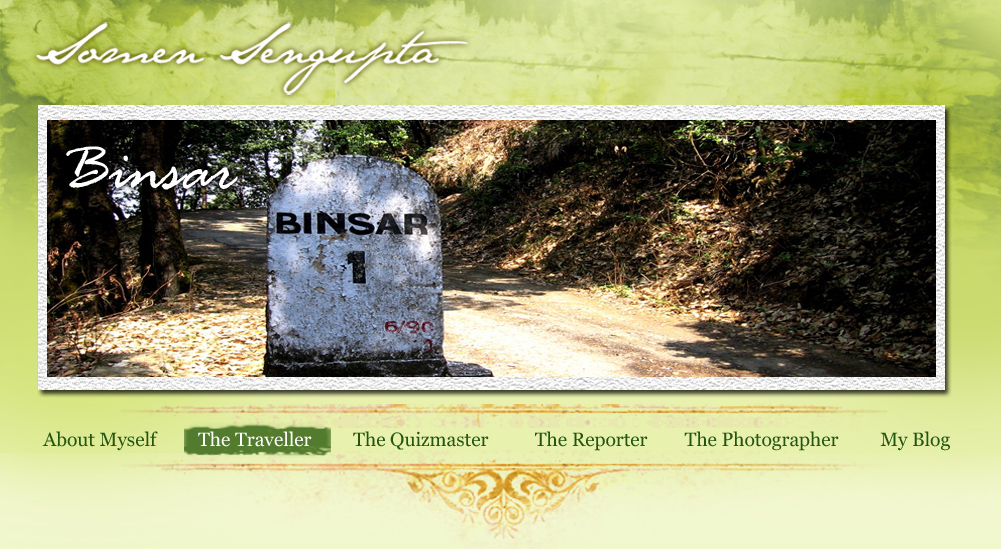| BINSAR : NIRVANA IN HOLY MOUNTAIN AND DARK WOOD |
|
The summer capital of the erstwhile Chand kings (7th - 18th century) of Kumaon, Binsar is a picturesque, sleepy hamlet and one of the most scenic spots in the Kumaon Himalayas.
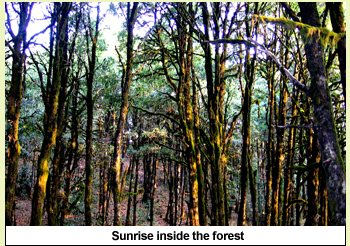 The moment a visitor enters inside the Kumaon Mandal Vikas Nigam (KMVN) tourist guest house of Binsar, a huge poster like photograph hanging on the wall grabs the attention. The poster shows how the horizon of Binsar looks from the terrace of the guest house on a bright clear day. This one picture tells almost everything about this almost unexploited hilltop that bears the footprint of mankind since last many centuries but contains its pristine beauty till this day. The picture is a roaring and breathtaking 340 km panorama of Himalaya where an army of peaks stand one after another. Be it Kamet, Nanda Devi, Mrigathuni, Nandakot, Trishul or Panchachulli the thrill of an encounter with peerless Himalaya is bound to overpower mind. It is that decisive moment when one forgets that he is at a place where there is no electricity after 7 pm, no cyber café, no internet and it is a place where propensity of romancing with nature scores over every luxury.
The moment a visitor enters inside the Kumaon Mandal Vikas Nigam (KMVN) tourist guest house of Binsar, a huge poster like photograph hanging on the wall grabs the attention. The poster shows how the horizon of Binsar looks from the terrace of the guest house on a bright clear day. This one picture tells almost everything about this almost unexploited hilltop that bears the footprint of mankind since last many centuries but contains its pristine beauty till this day. The picture is a roaring and breathtaking 340 km panorama of Himalaya where an army of peaks stand one after another. Be it Kamet, Nanda Devi, Mrigathuni, Nandakot, Trishul or Panchachulli the thrill of an encounter with peerless Himalaya is bound to overpower mind. It is that decisive moment when one forgets that he is at a place where there is no electricity after 7 pm, no cyber café, no internet and it is a place where propensity of romancing with nature scores over every luxury.
This is Binsar - a world where sound is not invited unless an automobile engine carrying tourist roars past. Imagine a world where wind whispers with towering oak and pine, and imagine a world where light and shadow play a game of hide and seek through deep forest thronging with wildlife and imagine the best of Kumaon Himalaya is watching you at a height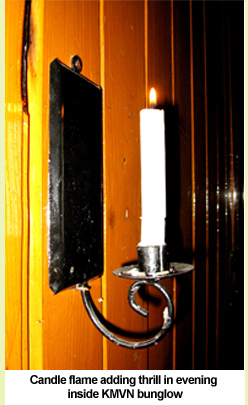 of 7916 ft. These all, in a nutshell, are enough to describe a place named Binsar, a hill retreat inside of a wildlife sanctuary which apart from tourist is also populated with rare birds and common beasts. of 7916 ft. These all, in a nutshell, are enough to describe a place named Binsar, a hill retreat inside of a wildlife sanctuary which apart from tourist is also populated with rare birds and common beasts.
This Wild Life Sanctuary of Uttarakhand was formed in 1988. Covering only an area of 47 square km this forest is covered with pine and oak at lower altitude and with rhododendron at the higher altitude. The flora of this forest is so rich that it contains seven kind of grasses & 25 types of trees. Several spices like cinnamon, turmeric, tyme etc are grown here. Binsar is not a newly discovered place. It was once the summer capital of Chand dynasty and even now as their last signature a 16th century temple dedicated to Lord Bineshwar, the local name of Shiva, is found here. The place got its name from the deity.
Records reveal that in 1852 a British East India Company's Major named Ivance first got some land to build his bunglow in Binsar hills. Soon the place was frequented by Europeans and it finally became a resting place of Kumaon's Commissioner. A British bunglow built in 1920, still stands inside the sanctuary where one can go to see a magical sunset in the evenings. It is near this colonial bunglow where a signboard planted by forest department clearly denotes that you are not in an ordinary place. Rather, from this point, the dark and deep forest starts. Animals like leopard, black bear, langur, barking deer, ghoral, red fox and birds like kaleej pheasants, jungle owls, minivets, black eagles, red billed blue magpies, cheer pheasants etc are habitants of this forest and roam near this point. The board says it all.
It is neither Himalaya nor the forest that gives the first thrill in Binsar. Immediately after reaching Binsar's KMVN a jungle walk can be undertaken as the jungle begins atleast 40 minutes before you reach the place. One needs to obtain permission from forest department after depositing an amount with some declaration. From that point, till the time the car reaches tourist spot nature on both side of the window clearly gives an indication that you are slowly disconencting from civilization. It is the sound of silence that wins 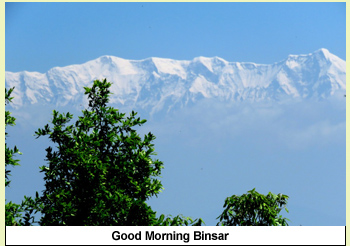 you over. Inside the jungle kingdom, it is silence that rules. It is the sound of wind that passes through the trunk of pine and it is the sound of breaking dry leaves under your feet that adds a chilling thrill in that mystic milieu. Here in the wood, unknown birds fly from one tree to another while an invisible magnet attracts every visitor deep inside the wildness. Early morning is the best to take the jungle walk. It is the time when sky of Binsar starts removing a cavern from its face exposing Kumaon Himalaya's unmatched beauty. you over. Inside the jungle kingdom, it is silence that rules. It is the sound of wind that passes through the trunk of pine and it is the sound of breaking dry leaves under your feet that adds a chilling thrill in that mystic milieu. Here in the wood, unknown birds fly from one tree to another while an invisible magnet attracts every visitor deep inside the wildness. Early morning is the best to take the jungle walk. It is the time when sky of Binsar starts removing a cavern from its face exposing Kumaon Himalaya's unmatched beauty.
Inside the jungle another beauty slowly unfolds itself. Here the sunlight dances on the meadows in early morning. Sunlight also kisses the trunk of trees slowly and with that dawn breaks in Binsar. Binsar is a paradise to bird watchers across India. Well trained wildlife guide takes tourists deep inside of the jungle where with apt attention you can hear various sounds and can sight birds. This meadow takes one to zero point - a 2km walk from KMVN guest house. If you are physically fit and nature enthusiast then take this walk to add a gem of memory. The wooden platform built at zero point is the highest point of Binsar and it is the place where in colonial times the Union Jack was hoisted during the visit of the commissioner to announce his arrival in Binsar.
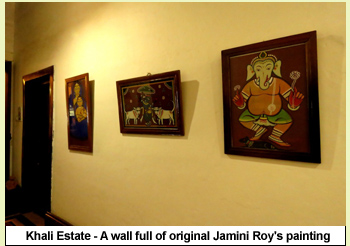 At zero point every pain of reaching Binsar will evaporate. If it is a clear day, Kumaon range of Himalaya will be so close to you as if you could reach out and touch it. From here two regions of Kumaon Himalaya, Nanda Devi and Panchachulli are visible. Panchachulli, the mountain with five ovens of Draupadi as its epic connected legend goes, is on the right side with five massive peaks while on the left plethora of peaks from Nanda Devi range stand. The most prominent peaks visible from Binsar are Nanda Devi, Nanda Devi east and Trishul. Nanda Devi East is also known as Sunanda Devi and the God fearing people of the region count both the peaks sacred. It is the south- west side of Nanda Devi that is seen from Binsar and it looks very different. One who has seen the same peak which was once considered India's height peak from any point of Garwal will find it unknown as the shape looks so different from here. Before the height of Kanchenjungha was measured, this 7816 mt high Nanda Devi was considered as India's highest peak. Like many other Himalayan peaks, British expedition team always had a wish to climb it. It started with HughRuttledge in 1930 who tried three time to climb it but failed in all. Then in 1936 H.W Tilman and Neol Odell finally reached the peak in 1934. If Nanda Devi is the biggest surprise seen from Binsar, then Trishul is perhaps the most beautiful peak that stands here. The 7120 mt high peak has three peaks and looks like a trident. It was first scaled in 1907 by TG Longstaff. Trishul looks huge from zero point of Binsar. At zero point every pain of reaching Binsar will evaporate. If it is a clear day, Kumaon range of Himalaya will be so close to you as if you could reach out and touch it. From here two regions of Kumaon Himalaya, Nanda Devi and Panchachulli are visible. Panchachulli, the mountain with five ovens of Draupadi as its epic connected legend goes, is on the right side with five massive peaks while on the left plethora of peaks from Nanda Devi range stand. The most prominent peaks visible from Binsar are Nanda Devi, Nanda Devi east and Trishul. Nanda Devi East is also known as Sunanda Devi and the God fearing people of the region count both the peaks sacred. It is the south- west side of Nanda Devi that is seen from Binsar and it looks very different. One who has seen the same peak which was once considered India's height peak from any point of Garwal will find it unknown as the shape looks so different from here. Before the height of Kanchenjungha was measured, this 7816 mt high Nanda Devi was considered as India's highest peak. Like many other Himalayan peaks, British expedition team always had a wish to climb it. It started with HughRuttledge in 1930 who tried three time to climb it but failed in all. Then in 1936 H.W Tilman and Neol Odell finally reached the peak in 1934. If Nanda Devi is the biggest surprise seen from Binsar, then Trishul is perhaps the most beautiful peak that stands here. The 7120 mt high peak has three peaks and looks like a trident. It was first scaled in 1907 by TG Longstaff. Trishul looks huge from zero point of Binsar.
If this engages one till afternoon, then post tea break, a walk towards sunset point can be taken. From here, the magic of evening starts. Evening in Binsar comes in style. Soon after the sunset birds start returning to their nests and darkness envelops the region quickly. It is the time when electricity is switched off and candles are lit up. Inside every cottage and room the flickering flame of candlelight start dancing. Light and shadow together in the tourist lodge create an amazing atmosphere.
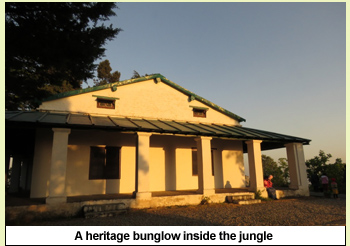 It is better to stay inside in Binsar when it is dark. Though not many people have seen with their own eyes, but the sound of roaring bear and leopards, the original inhabitants of Binsar is often heard. So wise it will be to enjoy a steaming cup of tea inside the room under a warm blanket. If it is full moon on a clear day, the risk of coming out to the terrace can be taken to enjoy sliver shinning peaks standing tall. It is better to stay inside in Binsar when it is dark. Though not many people have seen with their own eyes, but the sound of roaring bear and leopards, the original inhabitants of Binsar is often heard. So wise it will be to enjoy a steaming cup of tea inside the room under a warm blanket. If it is full moon on a clear day, the risk of coming out to the terrace can be taken to enjoy sliver shinning peaks standing tall.
A travel in Binsar will remain incomplete if a visit is not paid to Khali estate, a huge heritage bunglow built in 1875 by one Sir Henry Ramasay. With its wooden floor, vintage furniture, various antiques on the wall and decorated chandeliers, the bunglow has a strong colonial character. Now converted into a heritage hotel Khali estate has a unique thing that every lover of art will envy. There is a passage that leads one from library to living room of the bunglow - this corridor walls are full of Jamini Roy's paintings! Every painting is original and every painting contains the maverick's signature.
All is not well with Binsar today. It is now facing a unique issue. The nonstop man made fire in jungle for narrow commercial purpose is disturbing the ecosystem. It is not only polluting the air and reducing chance of viewing Himalaya more and more, it is also forcing a large number of leopards and Himalyan black bears to lose their home. It is feared as they are gradually moving to safer places and often get perplexed in finding their new abode. So man and animal conflict are on the rise in Kumaon. Binsar by no mean can escape from this danger.
Travel Logistics :
A leopard rehabitation centre for captured leopard by Uttarakhand Govt is now open to tourist - one can visit and see original royal citizen of Binsar.
Binsar is just 30 km from Almora and car is the only mode of transportation.
Special permission is needed from forest department - keep your i-card ready.
KMVN guest house is the best place to stay though more luxury accommodations are available at lower altitudes and far from jungle.
Useful website : www.kmvn.gov.in and www.uttarakhandtourism.gov.in
Never come out of your guest house after sundow.
This article was published in The Hitavada on 12th March 2017
Click here to view the original article
|
